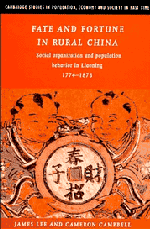Book contents
- Frontmatter
- Contents
- List of figures
- List of maps
- List of tables
- Acknowledgements
- PART 1 DAOYI VILLAGE
- PART 2 THE LIAONING DEMOGRAPHIC SYSTEM
- PART 3 HOUSEHOLD ORGANIZATION AND POPULATION BEHAVIOR
- PART 4 BANNER ORGANIZATION AND POPULATION BEHAVIOR
- EPILOGUE: PROSPECTS, IMPLICATIONS, AND COMPARISONS
- Appendices
- A Sources and methods for the population and family history of rural Liaoning
- B Statistical techniques
- C Household division contract of Lang Zhongqing and Lang Wenlin
- Glossary
- References
- Index
- Cambridge Studies in Population, Economy and Society in Past Time
B - Statistical techniques
Published online by Cambridge University Press: 20 October 2009
- Frontmatter
- Contents
- List of figures
- List of maps
- List of tables
- Acknowledgements
- PART 1 DAOYI VILLAGE
- PART 2 THE LIAONING DEMOGRAPHIC SYSTEM
- PART 3 HOUSEHOLD ORGANIZATION AND POPULATION BEHAVIOR
- PART 4 BANNER ORGANIZATION AND POPULATION BEHAVIOR
- EPILOGUE: PROSPECTS, IMPLICATIONS, AND COMPARISONS
- Appendices
- A Sources and methods for the population and family history of rural Liaoning
- B Statistical techniques
- C Household division contract of Lang Zhongqing and Lang Wenlin
- Glossary
- References
- Index
- Cambridge Studies in Population, Economy and Society in Past Time
Summary
In this appendix, we attempt to explain briefly the two statistical techniques we use that may not be familiar to our readers: life tables and logistic regression. The explanations we provide are meant simply to give the reader an idea of what we are doing and are thus not very detailed nor very rigorous. Readers seeking more detailed explanations should consult the works listed as references. We assume that readers have already been exposed to elementary statistical methods such as linear regression and correlation, and do not explain them here.
Life table analysis
In Chapter 4, we rely on life table measures of mortality. Life tables summarize age-specific death rates by sex and from them calculate life expectancies and other indices at various ages. For the purposes of comparison between populations or over time, life table measures are more useful than crude death rates because they are unaffected by the age distribution. For example, whereas two populations with identical age-specific death rates but different age distributions are likely to have different crude death rates, they will have identical life expectancies.
Life table notation is standardized: nmx normally denotes the death rate per thousand person-years at risk between ages x and x + n, and nqx, corresponds to the probability of dying by age x + n conditional upon being alive at age x. Life expectancy at age x, ex, is the number of additional years an individual can expect to live conditional upon living to age x. For example, e5, is the number of years a five-year-old can still expect to live.
- Type
- Chapter
- Information
- Fate and Fortune in Rural ChinaSocial Organization and Population Behavior in Liaoning 1774–1873, pp. 238 - 245Publisher: Cambridge University PressPrint publication year: 1997



